Trey Sermon: What does he add, and how will he fill in for Jeff Wilson Jr? Plus, reviewing the NFC West Arms Race: Part 1 - Arizona Cardinals
Looking at what Trey Sermon can do in light of Jeff Wilson's meniscus tear, and grading the Cardinals major offseason moves.
Santa Clara, CA - Not even a day into offseason training, and the injuries are back. Like most sequels, this is not a good thing. If you didn’t hear, 4th year RB and inhabitant of dark place Jeff Wilson Jr went down with a meniscus tear, and we now know that it was last week. A more accurate description rather than “went down” would be that he stood up:

Yeah, the 49ers luck is that bad. Is it luck at this point, or is there more of an issue with the training staff than we know? Is Levi’s built on a Native American burial ground? It’s a legitimate question (the former, not the latter, I hope), but let’s make this clear: the 49ers have been among the league leaders in injuries since their 2012 run with Colin Kaepernick and Jim Harbaugh at the helm. They were statistically the least injured team in football, and since then, it’s all been downhill in terms of health for the 49ers.
Wilson going down is tough, considering that he really came into his own last season and was quite productive behind Raheem Mostert, providing an excellent change of pace with his powerful running style.
But if there’s any silver lining, it’s the fact that we will be seeing a lot of Trey Sermon, this year’s 3rd round pick. This is the highest that Kyle Shanahan has selected a RB in his tenure as 49ers HC, which should speak to what he thinks of Sermon. He runs angry, he runs powerful, and if he can’t run straight through you or push you aside, he will jump over you.
Running back is one of the few positions in football where a rookie can light it up from Day One, and with Raheem Mostert’s injury issues, Sermon is going to get a lot of carries to reduce Mostert’s workload. And he has the talent to do that, and more, I think Sermon can be a bell-cow type of back. He’s constantly falling forward, constantly bouncing off the first tackler, and has that innate ability of being able to slither through holes.
Beats the LB to the sideline, finishes the run strong, gets an easy 10 yards while out-running Jayson Oweh, who runs a 4.4. Sermon doesn’t have elite homerun speed, but his short area quickness and acceleration are elite.
He can pass-block. He can run routes out of the backfield, he never fumbled at Ohio State. All the fundamentals are there.
Sermon is going to have to take on a bigger than expected role, to start the season, and I believe he will respond and pass this test with flying colors.
By now, it’s basically a tradition for the NFC West teams to get even better, every offseason, constantly one-upping each other. The 49ers got involved with the move of the offseason, trading three firsts to land Trey Lance, but the Cardinals and Rams were very involved this offseason as well. The Cardinals had a very eventful offseason, and while there were some moves that I have mixed thoughts on, they certainly improved a lot this offseason, and it’s seldom being talked about. Let’s get into breaking down the major moves they made this offseason, starting with the biggest name in…
JJ Watt, DL - 2 years, $31,000,000 - $23M guaranteed
Watt isn’t what he was, let’s get that out of the way. He’s been on the decline for years. But I still really liked this move for the Cardinals. It was likely a little on the higher-end of what I expected Watt to garner on the open-market, but it is going to make the Cardinals defense very good. There are a couple of stats that will prove my point:
When you see JJ Watt’s traditional statistics over the past two seasons, it’s not impressive. Watt had 5 sacks and 29 pressures last season in 16 games, which isn’t bad by any means, but it’s not justifying a nearly $16M per year price tag.
But there is far more to the story than sacks and pressures. First, it cannot be understated how bad Houston was last season - they were an 0-16 team that was carried to 4 wins by now-troubled QB DeShaun Watson. The defensive line was devoid of talent as was the secondary, save for a couple of bright spots like Justin Reid and Zach Cunningham. Watt was the clear focus for offenses - a player they game-planned against. And that’s valuable.
Watt was the most double-teamed EDGE rusher in the NFL last season - clearly showing the respect that offenses had for him. Watt also was outstanding in run defense, notching 26 run stops last season - 3rd in the NFL. He also finished 3rd in the NFL in run stuffs (tackles specifically at or behind the LOS). Watt was graded as the 8th best edge defender in the league by PFF, not only because of the attention he garnered, but because of his still outstanding run defense.
Why is this important? Well, the last time Watt had another legitimately good defensive lineman on his team, it was Jadeveon Clowney in 2018. Watt’s statline that year?
16 sacks, 60 pressures. That was now two years ago, and a serious injury has occurred since as well - but it can’t be understated that Watt will benefit a ton from the attention that Chandler Jones garners - a top five EDGE rusher in the league. He’s going to impact the game. Think Justin Smith, late in his career with the 49ers - that’s the type of impact that Watt can make.
Grade: A-
In general, I felt this was an overpay - especially for an aging DL with some injury issues, though I believe those are overstated. But Watt is still an elite run defender and a good pass-rusher who is sure to be better with less attention on him - you can’t tiptoe around this, this is a good signing by the Cardinals and one that will make their defense very good.
AJ Green, WR - 1 year, $8,500,000 - $6M guaranteed
This was… something. Green’s name has carried more weight than his actual play over the past couple of seasons, but he’s still a decent WR and can be the WR2 in the Cardinals offense. He’s a good player, but I don’t believe he’s worth that price tag either. He’s lost the separation skills he once had, due to age - but his route running and high point ability are still good. The problem is how to evaluate him - his 2020 season was not good. He caught less than 50% of his targets for the first time in his career, despite not dropping many passes - suggesting he could not separate.
PFF supports that theory - 40.6% of AJ Green’s targets were contested, the highest in the league among qualifiers by more than 5 percentage points. Despite that, he still caught a decent amount of the contested catches, which is why he’s still a decent player - he’s not the impact player that his name suggests however.
Green will likely benefit a lot from having DeAndre Hopkins garner so much attention, and Murray could build a connection, but this signing was underwhelming for the price-tag. An underrated aspect of this signing is that it will move Christian Kirk into the slot, a place where he could do far more damage and become a potent receiving threat.
Grade: C-
Overpay for sure, and it remains to be seen if Green will continue his decline or if he bounces back. He will definitely be helped by better QB play in Arizona and less attention placed on him, but is that enough to justify almost 9M?
Malcolm Butler, CB - 1 year, $3,250,000 - $3.25M guaranteed
Great move. Butler can still play. Although he’s not the player that he’s often remembered to be for his late Super Bowl heroics against the Seahawks a short while ago. He’s an upgrade over Patrick Peterson at their respective stages of their careers, and comes at a cheaper price to keep. Butler was the highest-graded cornerback in football over the final five weeks of the 2020 regular season - a sign that he still has gas left in the tank, even as his play fluctuated between below average and very good over the past couple of seasons.
He fills a need, he does so at a bargain value, and he can still play at a high-level.
Grade: A+
Great value, good player, acquisition at important position of need. It checks all the boxes of an A+ signing. Butler will give them a solid year of CB play at minimum while being very cap-friendly - a move that makes sense on every level.
Rodney Hudson, C acquired for 3rd round pick
Good move, but another overpay - Las Vegas was actually going to release Hudson, but Arizona jumped on it to pay a premium of a 3rd round pick. Hudson is 31, and he has a couple years of high-level play left, but the age is what makes it an overpay. As a pure player, Hudson is one of the best centers in the league and should give Kyler Murray peace of mind behind an OL that was previously weak on the interior. Not any longer.
Grade: B
A 3rd round pick feels rich for Hudson at his age, but the player being acquired, age not included, is absolutely worth that pick. Arizona clearly believes that Hudson can last a couple more years with high-level play and justify the price paid, and it’s not a bad bet to make. A good move, but nothing amazing. Hudson is most definitely going to help against Aaron Donald and the other elite interior lineman that Arizona will play next year.
1.16 - Zaven Collins, LB, Tulsa
2.49 - Rondale Moore, WR, Purdue
4.136 - Marco Wilson, CB, Florida
It was an odd draft for Arizona. I think all three of the players that Arizona picked are good picks, no doubt - especially Moore, who if he stays healthy, can and likely will be a nightmare to deal with. He has work to do in terms of being able to make plays downfield, but Moore is incredible with the ball in his hands. Why is it odd? I’ll get into it later.
Collins can play outside or inside LB (but will play inside LB with the Cardinals) and is incredibly athletic and gifted with his size, reminiscent of Tremaine Edmunds from a couple years back. Sideline to sideline and he hits with authority. If he can fine-tune his reactionary skills and instincts, he can be a force.
As for Marco Wilson, Wilson is a gifted outside corner with length, but he’s the definition of a project and won’t be seeing the field, in all likelihood, in 2021. If he responds to coaching and can overhaul his technique, especially in man, he can definitely be a contributor.
Grade: B
While Wilson makes sense from a needs-perspective, Collins and Moore do not. Arizona already had Isaiah Simmons and Jordan Hicks on the inside, and while Hicks isn’t the best, he’s been serviceable. Arizona could have taken their own “freak” at DB with Caleb Farley, and taken a LB later, which makes it a head-scratcher. And Moore, although awesome (he runs a 4.3, squats three times his body weight, has a 42 inch vertical) is really undersized. He’s a slot WR in the NFL, which begs the question - what in the world are the Cardinals going to do with both Christian Kirk and Andy Isabella, both of whom have been very good, with the former in Kirk being a great slot WR? Expect even more 4-WR sets, I guess. It was very much a BPA draft, and that’s OK - in fact, it’s been more successful than a traditional needs-based draft strategy at times. But passing on Caleb Farley and Greg Newsome, even with the injury red-flag (which was cleared pre-draft for Farley) - certainly interesting.

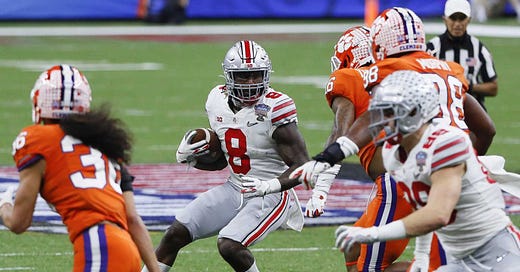




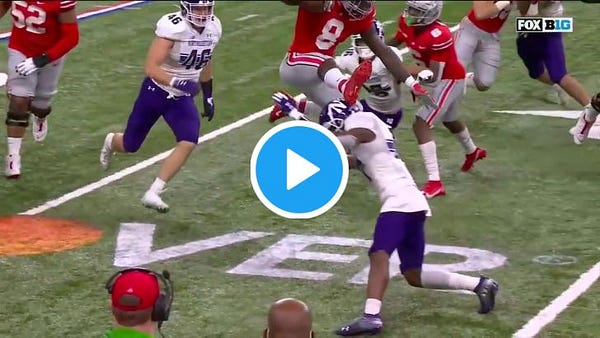
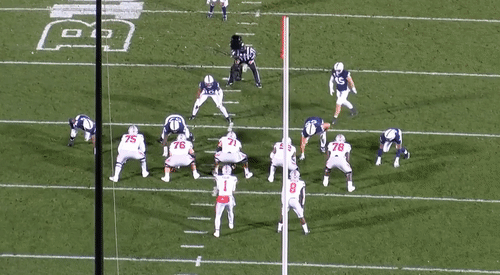

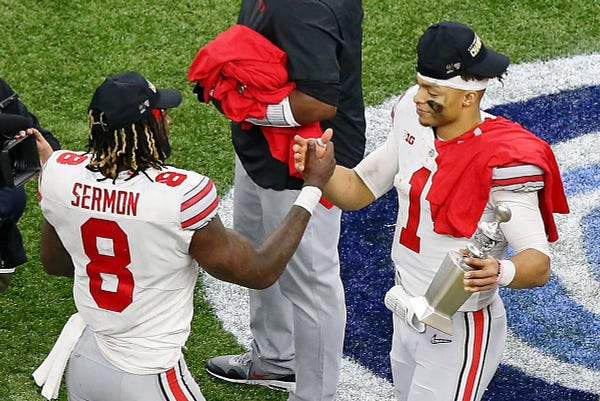
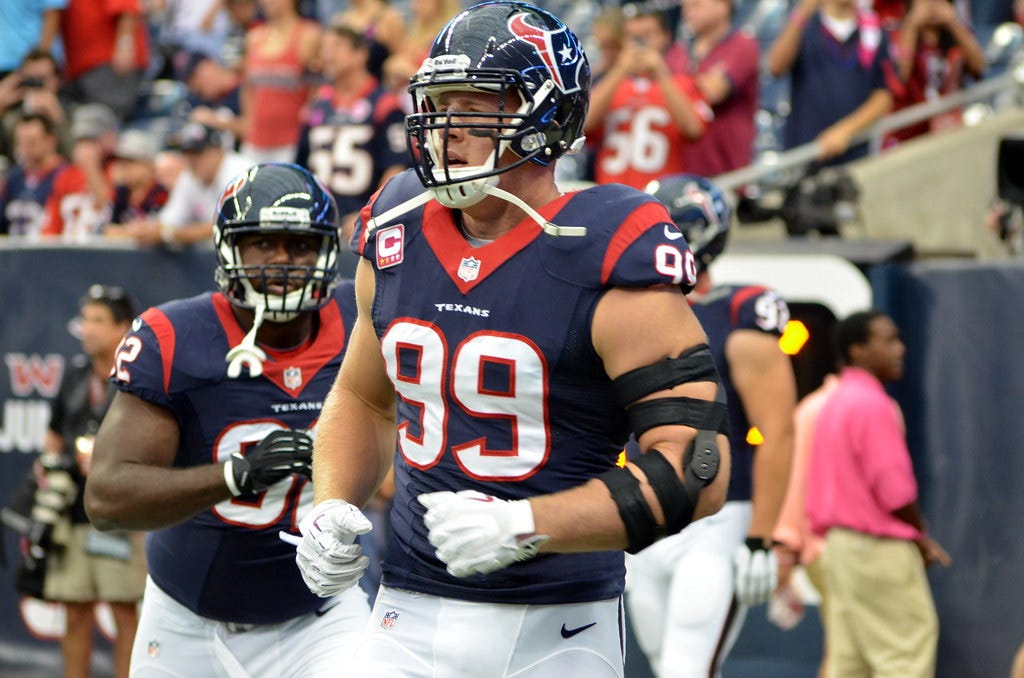
Trey Sermon is gonna be a beast. Mitchell intrigues me though. Maybe he doesn't do much, or maybe he learns to be the receiving threat Shanahan wanted from Jet. I think we'll get a peak in camp what Shanahan has in mind, but it won't be till end of the season till we really know. This backfield looks fast and explosive and can't wait to see it on the field.
Man, AZ had a great offseason. NFCW is going to be brutal. Again.